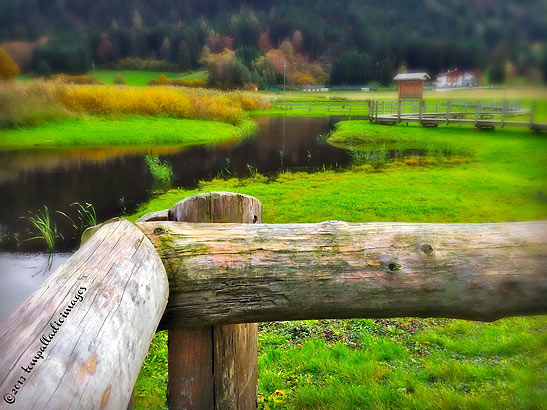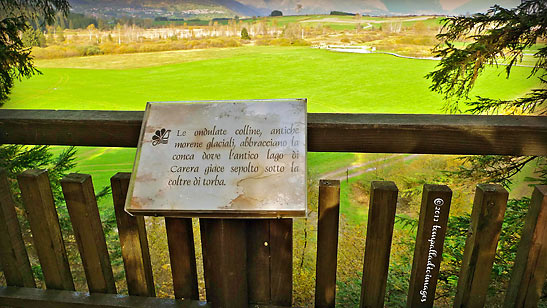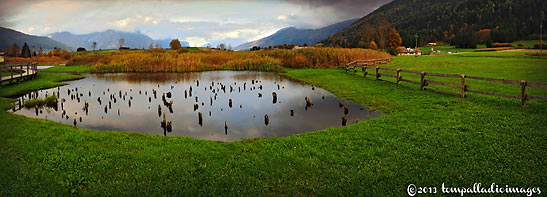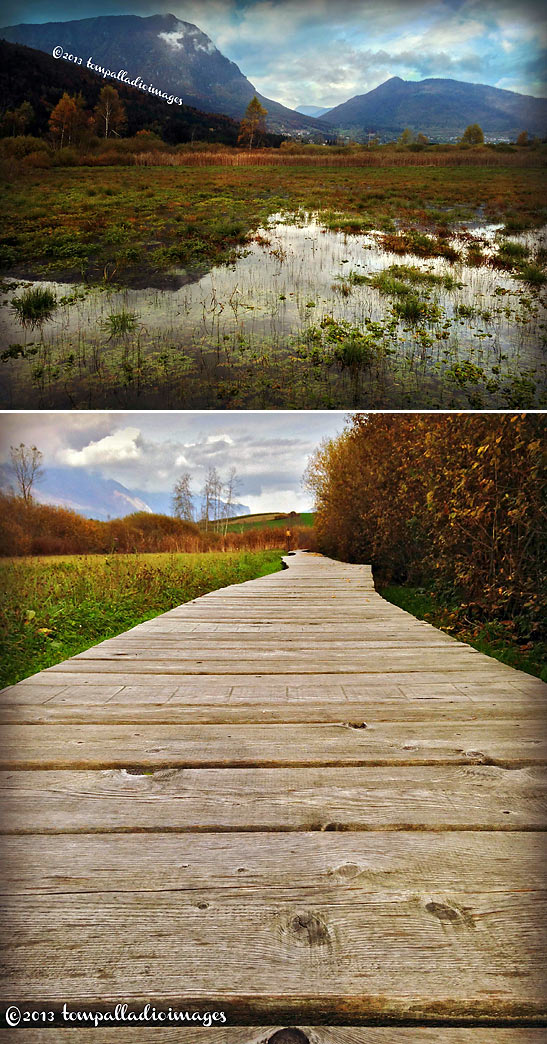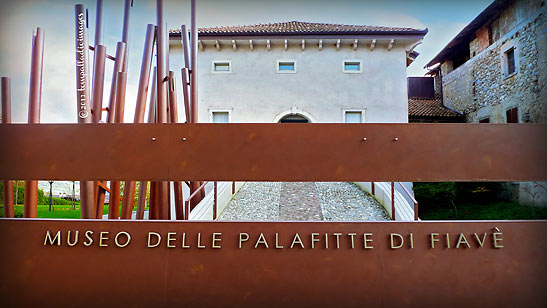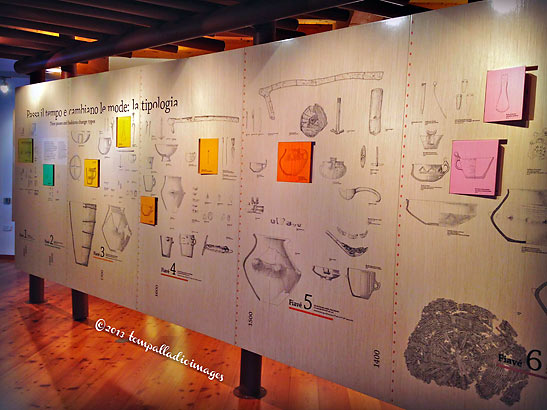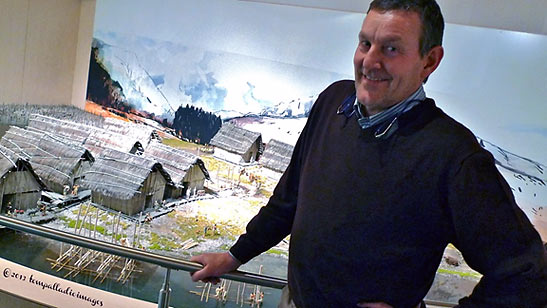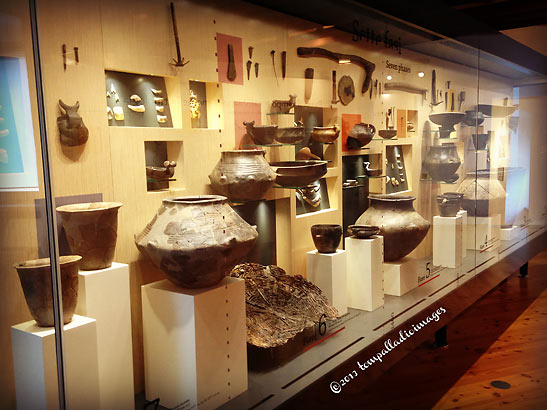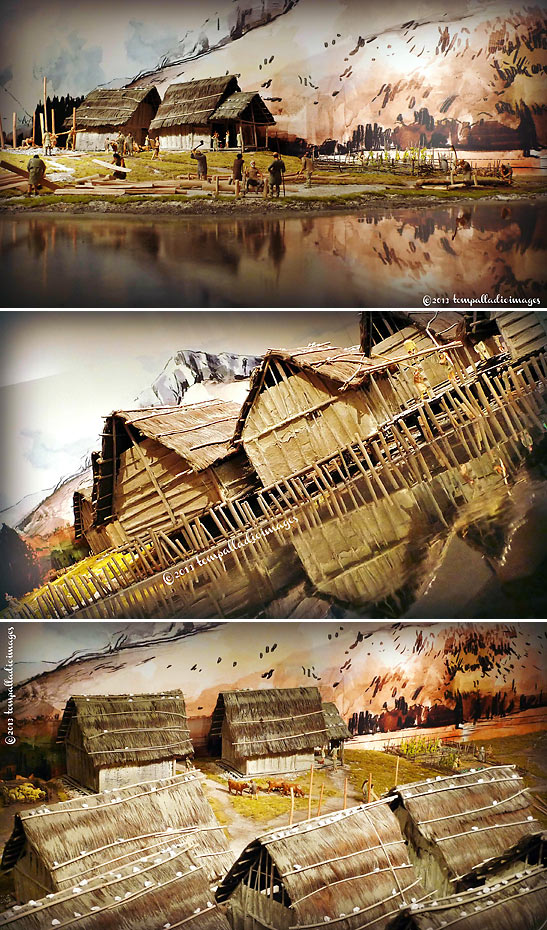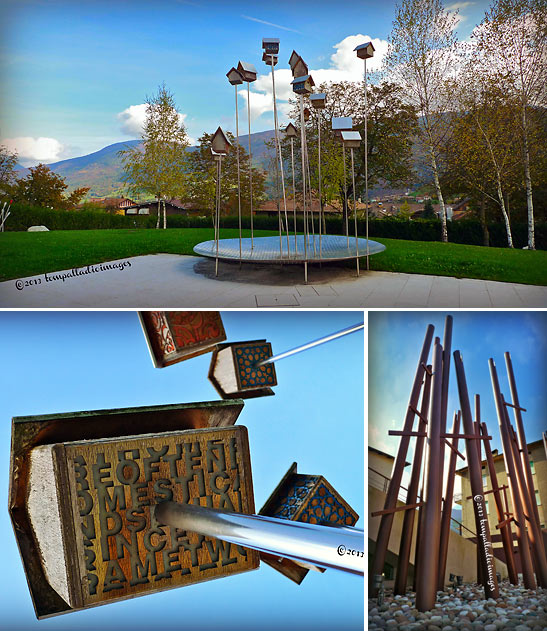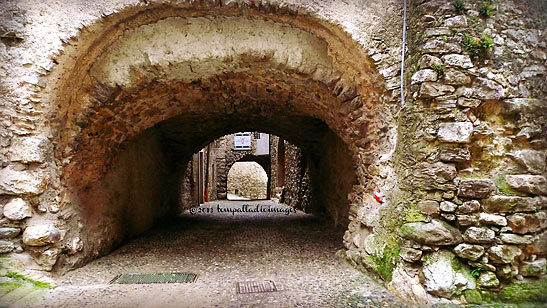 |
 |
|
 |

|
Under Doctor's
Orders:
Fiavè – Life on Stilts Story and photos by Tom Weber
Funny, I came to the Trentino for a modern-day spa treatment, but, in between my two-a-day water therapies, I ended up visiting an archeological dig and then being lectured about the Stone and Bronze Ages at Il Museo delle Palafitte di Fiavè (Pile Dwellings Museum of Fiavè – MPF).
They don't call this part of Europe "old as mud" for nothing, as evidenced by the remains of those 7-9m long wooden stilts – driven into the soft underbelly of the lake millennia ago – peering back at me just above the surface of the now glacial basin-turned-peat bog.
Looking around at this little speck on the prehistoric map, wondering what life was like right here on this very spot some 6,000 or so years ago, really got my Vespa running. I needed to do some digging of my own and get to the bottom of this story about life on prehistoric stilts.
Arriving at MPF, I flash my press credentials, fill out a form and the pleasant administrator, Elena Brocchetti, waives the small €3.50-entry fee, provides me with all the literature I can carry, and immediately hands me off to Signor Angelo Parisi. Angelo tells me straight away that, "I'm not an archeologist, but I am very, very passionate about the museum." And it showed, as he served as my guide for the afternoon and led the way on a private, in-depth, VIP tour of the brand new, three-story, state-of-the-art facility that occupies the old Casa Carli in the center of Fiave.'
The museum, devoted entirely to those ancient "holes in the ground making history," is laid out to illustrate – via plenty of interactive audio-visual screens, colorful static displays, glass cases filled with precious artifacts, and various mock-ups – the seven stages of the three prehistoric communities that lived around the glacial basin between the late Neolithic Age and the recent Bronze Age. The Lake Carera finds are part of an overall 111 locations of prehistoric pile dwellings around the Alps fully recognized by UNESCO and designated as World Heritage sites.
The informative walk around with the very knowledgeable Angelo, who, as a young student, assisted the discovery efforts at the archeological dig during the 1970s, shows the various construction types used to build the settlements, and demonstrates quite clearly how these ancient Alpine tribes went about their daily lives, survived and thrived.
The museum's collection of objects and artifacts, dating back to nearly 4,000 B.C., is one of the most impressive of its kind: pottery, jewelry in bronze, Baltic amber and even gold; tableware and kitchen utensils; and, a variety of farming and working tools, like hammers, sickles, drills, axe handles and ploughs. Perishables are also on display, and include food: ears of corn, cherries, hazelnuts, apples and pears.
On the third floor, and the last stage of the tour, visitors can experience "A day in a pile dwelling." It's a complete model recreation of a day in the life of a community on stilts some 3,400 years ago.
After thanking my personal guide and the administrator for their gracious hospitality, I took a stroll around the museum's park-like grounds with the impressive bird house sculpture out back and the angled, symbolic palafitte (stilts) that front the museum's entryway. The day trip now complete, I give Il Museo delle Palafitte di Fiavè and the archeological site at Lago Carera "two thumbs" way up; or, in the words of Fred Flintstone: Yabba-dabba-doo!
For complete information on the museum and the archeological dig, as well as a host of other scenic gems tucked away in the Brenta Dolomites, just visit the Tourism Office of the Trentino.
Join me again next time when I follow my doctor's orders and remove the lens to capture a medieval lakeside village that has withstood the test of time: Canale di Tenno. Related Articles:
|
|
Feedback for Destination Bosnia: Inside Sarajevo's Tunnel of Hope Spent time in Sarajevo in the fall of 1973…beer was excellent! --- David * * * * Hi Tom, I must say, you're photographs are always amazing. They are top notch. You bring so much class to Traveling Boy. It's photographs like yours that make me want to go out and do my own traveling. Please don't get tired of sending us your amazing adventures. It's such a delight for the soul. --- Raoul, Whittier, CA * * * * Hi Tom: --- David * * * * Hey Tom – Wow! Love those photos – they are so super that they make me A) Want to start eating NOW. B) Go there myself. C) See all that pristine beauty that looks so restful and peaceful. Great story, superb pix!!! Bravo!! --- John, Los Angeles, CA * * * * Feedback for Destination Southwestern France: Saint-Émilion Good job, Tom, and timely info. St. Émilion is in the list of places Jim Hayes and I will visit in September 2014. If we get the chance, we will exploit your experience to enhance the trip! --- Bobby Harper, Dameron, MD * * * * Feedback for Vicenza Walks – Monte Berico I lived in Vicenza for 4 years in the U.S. ARMY from 1963 to 1967. A wonderful place to explore. Palladio’s works are amazing. Have been back twice since and find new places to visit. My favorite is MONTE BERICO where I have some wonderful photos of my family. --- Dr. Albert Pizzi, Hanover, MA * * * * I liked the new TB particularly the Vicenza article that took me back as a youth when we lived in Naples and travelled up there for a baseball tourney (U.S. Military Bases dependent schools played each other.) Took me back to the plaza. --- Bill Feedback for A Canterbury Trail (Sutri) Very interesting note. I have wedroned which route the early pre-Christian and Christian pilgrims travelled to Rome from England. Is it still possible to travel the Francigena trail? --- Pawel You can find out more info on walking tours of Via Francigena at this site: http://www.compagniadeicammini.it/en/. Thanks for stopping by and commenting.. Tom * * * * Good article, enjoyed reading it. Saved your recommended sights for future use. --- Dardenne Prairie, MO * * * * You're going to be great at this Tom. Congrats. --- Donna Vissa -Montreal
|
This site is designed and maintained by WYNK Marketing. Send all technical issues to: support@wynkmarketing.com

|






